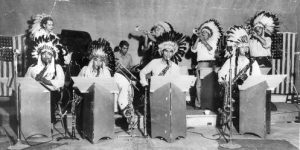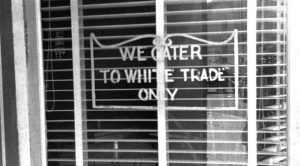5
Nezpercians and the Discrimination Sleepover
Rebekka Boysen-Taylor

Take a few minutes to just look at the image above.
What do you see in the image?
What questions do you have about what you see?
How does this connect to things you already know or are learning about?
Read the article that accompanied the image to learn more…
Lewiston Tribune Article, Feb. 17, 2013
Most might not associate jazz music with American Indian culture – stereotypical images tend to come to mind first.
But starting as early as the 1920s, Nez Perce tribal members in Lapwai formed their own jazz bands, including one called the Nezpercians. They traveled hundreds of miles to play wherever they could get a gig, spreading their culture and love of jazz.
In fact, they jammed with Lionel Hampton in Portland, Ore., in the early 1930s during what the daughter of one band member described as a “discrimination sleepover.”
Hampton, the namesake for the University of Idaho Lionel Hampton Jazz Festival, which begins Wednesday in Moscow, is known for being one of jazz’s first vibraphone players and a legend in the music industry. That had little sway in 1930s America for a Black man trying to find lodging.
Veronica Mae Taylor of Lapwai, daughter of Harry Pete (Fox) McCormack, who played the drums for the Nezpercians, said her dad’s and Hampton’s groups played at a nightclub in Portland during the same week and ended up connecting with one another.
“Well, it got to be late at night and nobody had made arrangements for (Hampton’s band) to stay in a motel or anything,” Taylor said.
Hampton and his band discovered they were expected to sleep on the floor of the nightclub. So, the Nezpercians invited them to stay in their rooms, and they became fast friends.
Some other words for expanded context…
Whose stories are included here?
Who is telling the story?
The significant contributions of Idaho Indigenous tribal members to the jazz community are largely hidden. In this artifact, we see an instance of community building between African American and Nez Perce musicians brought together by their musical expertise and by a group of Nez Perce jazz artists, the Nezpercians, showing solidarity with Black jazz artists when they offered Lionel Hampton and his housing in response to racial segregation in Oregon which meant that Hampton’s band was expected to sleep on the floor of the nightclub they performed at. This act started a long-term connection between Hampton and the Nez Perce.
Why was it hard for Black artists to find hotels in Oregon in the 1930’s?

Oregon was founded as a whites-only state through three Black exclusion laws. The first two exclusion laws were created while Oregon was still a territory. These laws prohibited bringing slaves into Oregon and barred Black, or biracial persons with Black lineage, from the state. The final law was included in the Oregon Constitution and prevented the ownership of land or property by Black people. This constitutional clause was not removed until 2002 when voters approved a measure to remove constitutional references to race.
To learn more about Black History in Oregon, visit Oregon Humanities’ A Hidden History.

